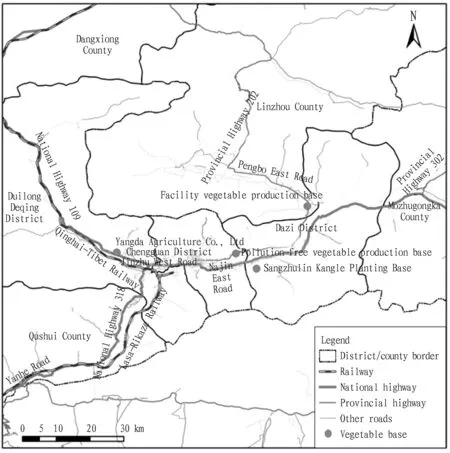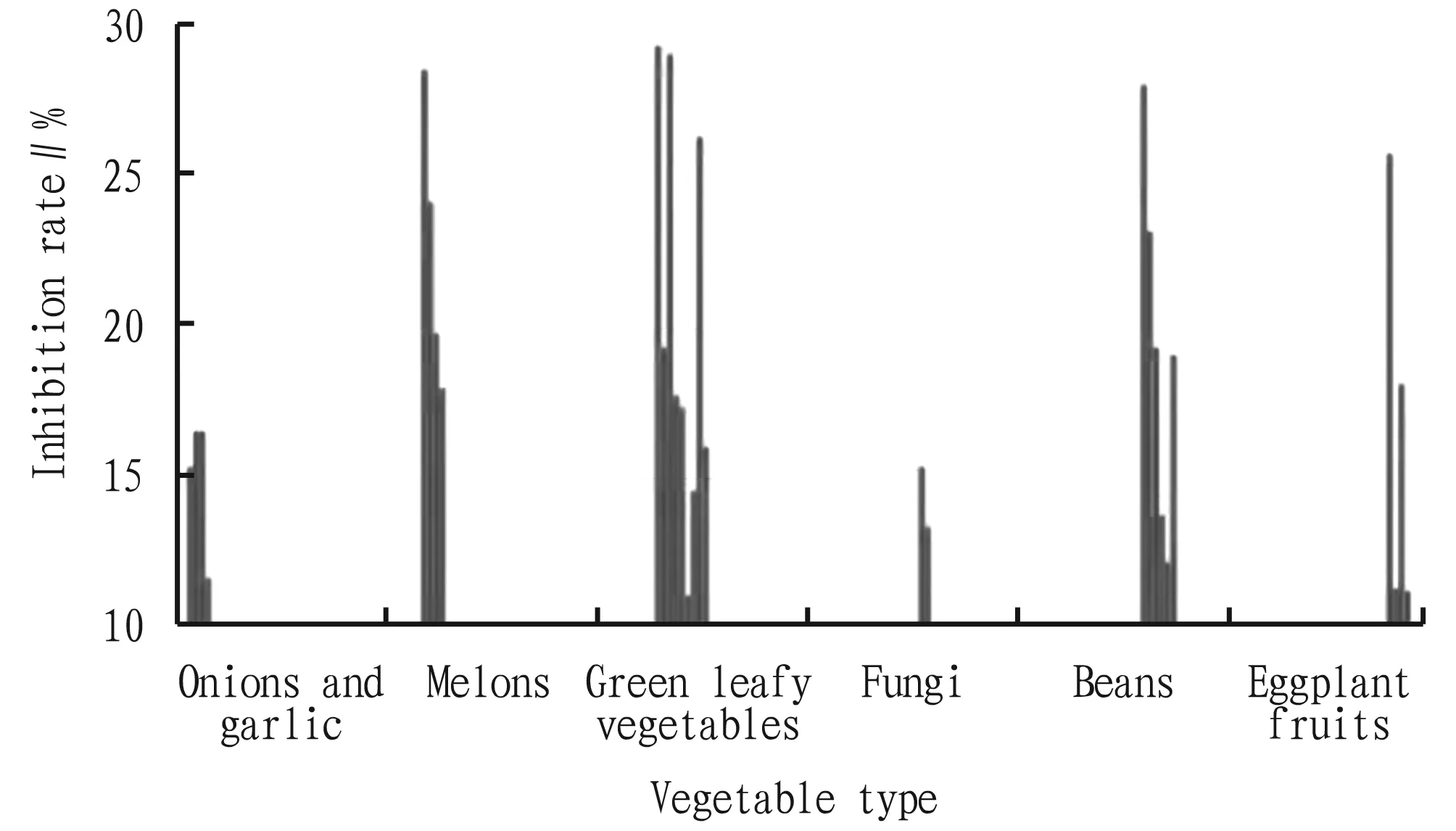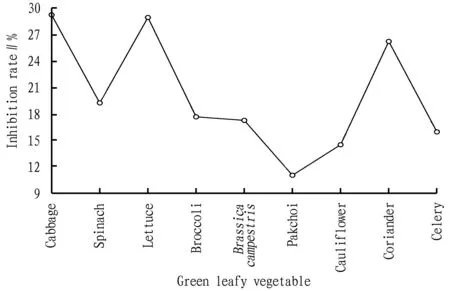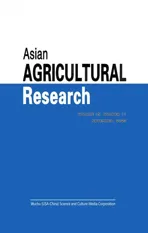Pesticide Residue Content in Vegetable Bases of Lhasa City
2023-12-01YaodiLIURuiyangCHEN
Yaodi LIU, Ruiyang CHEN
Tibet University, Tibet 850000, China
Abstract [Objectives] To understand the quality safety of vegetables produced in vegetable planting bases around Lhasa City. [Methods] Four vegetable planting bases in the east, west, south, and north of Lhasa City were randomly selected for testing using rapid measuring instrument for agricultural residues and solid-phase microextraction-gas chromatography-mass spectrometer, with 120 vegetable samples selected. The testing samples included seven categories: green leafy vegetables, eggplants, melons, onions and garlic, root vegetables, beans, and fungi, totaling 29 types of vegetables. The samples were tested for 8 common prohibited and restricted pesticides in organic phosphorus and carbamate esters, including methamidophos, parathion, methyl parathion, monocrotophos, isocarbophos, methamidophos, aldicarb, and carbofuran. [Results] The pesticide inhibition rate of 6 kinds of vegetables detected by the rapid measuring instrument for agricultural residues was relatively high, with green leafy vegetables being the majority, reaching over 25%. By further establishing a solid-phase microextraction-gas chromatography-tandem mass spectrometry method, the accuracy of the data was verified experimentally. The experimental results indicated that the inhibition rate of vegetable samples in this experiment did not exceed 15%, and it was determined as a pollution-free vegetable. [Conclusions] According to the restriction standard of national pesticide use, the inhibition rate of vegetable samples was less than or equal to 40%, indicating that the quality of vegetables was qualified.
Key words Vegetable, Solid-phase microextraction, Pesticide residue, Organophosphorus pesticide, Lhasa of Tibet
1 Introduction
Tibet is one of the regions with the best ecological environment quality in the world, and Lhasa is the capital of Tibet. With the continuous improvement of living standards, the demand for vegetables among people in plateau areas is constantly increasing, and the requirements for vegetable quality are also constantly strengthening. Due to its location on a plateau, special geographical location, and social and economic development, greenhouse vegetables have become an indispensable part of the vegetable supply chain in Lhasa City. According to incomplete statistics, the planting area of vegetable facilities in Lhasa City reached 1 595 ha, with most vegetables such as cabbage, potatoes, green peppers, carrots and other essential vegetables planted. The local vegetable supply reached about 80% of the market share during peak seasons. In recent years, the government has strongly supported the development of farmers, and the vegetable base area in Lhasa City has been continuously increasing. It has brought considerable income to more and more farmers by planting and selling vegetables, and has also driven the economic development of Lhasa City. But diseases and pests in vegetable bases are more and more serious. In order to ensure the supply of vegetables, efficient and convenient chemical control has become one of the important means of vegetable bases, which has led to the problem of pesticide residues in vegetables[1]. Pesticide residues not only cause pollution to the ecological environment, but also threaten people’s physical health[2].
After investigation, it was found that organic phosphorus and carbamate pesticides were used mostly in Lhasa vegetable bases. This study mainly examines the use of prohibited and restricted pesticides in these two types. There are many methods for detecting and analyzing pesticide residues in vegetables at home and abroad, among which enzyme inhibition method, gas chromatography and its combination technology, enzyme-linked immunosorbent assay, gas chromatography-mass spectrometry,etc.are commonly used. This study takes into account the rapid volatilization of pesticides due to sufficient sunlight in Lhasa City. After sampling is completed, rapid detection instrument for agricultural residues is used to measure the pesticide residue in vegetables. The result is used as a preliminary standard for determining whether vegetables are qualified. The accuracy is then verified using solid-phase microextraction-gas chromatography-tandem mass spectrometry. Solid-phase microextraction (SPME) is a commonly used sample pretreatment technology, which has the advantages of being green, efficient, and convenient compared to traditional pesticide residue detection methods. The gas chromatography-tandem mass spectrometry method has the advantages of simple and fast operation, high detection sensitivity, good reproducibility, precision, and recovery rate, providing effective technical support for vegetable safety supervision[3].
2 Materials and methods
2.1Instrumentsandreagents
2.1.1Instruments. Rapid detection instrument for pesticide residues, gas chromatography-mass spectrometry (GC-MS), electronic analytical balance, ultrasonic cleaner, nitrogen blowing instrument, food grinder, centrifuge, solid-phase microextraction device, ultrapure water preparation system, microwave digestion instrument, constant-temperature drying oven, centrifuge tube, conical flask, filter head, sterile syringe, pipette, conventional laboratory glassware.
2.1.2Reagent. Standard solutions for methamidophos, parathion, methyl parathion, monocrotophos, isocarbophos, methomyl, aldicarb, and carbofuran pesticides.
2.2SourceandcollectionoftestingsamplesThe four major vegetable planting bases in the east, west, south and north of Lhasa City were randomly sampled: Caigongtang Township Pollution-free Vegetable Production Base in the east, Duilong Deqing District Yangda Agriculture Co., Ltd. in the west, Sangzhulin Kangle Planting Base in the south, and Dazi County Facility Vegetable Production Base in the north. The specific geographical location is shown in Fig.1.
The vegetables include seven categories: green leafy vegetables, eggplant fruits, melons, onions and garlic, root vegetables, beans, and fungi, totaling 29 types of vegetables. The specific types of vegetable samples are shown in Table 1. 1-2 vegetable samples are taken from four vegetable planting bases, totaling 120 samples.

Fig.1 Location of four major vegetable planting bases in the east, west, south, and north of Lhasa City

Table 1 Types of vegetable samples
2.3SampledetectionandanalysismethodsThe experiment selected eight main prohibited and restricted pesticides from organic phosphorus and carbamate esters, including methamidophos, parathion, methyl parathion, monocrotophos, isocarbophos, methomyl, aldicarb, and carbofuran. In accordance with the national standardRapidDetectionofOrganophosphorusandCarbamatePesticideResiduesinVegetables(GB/T5009.199-2) and the industry standardRapidDetectionMethodofOrganophosphorusandCarbamatePesticideResiduesinVegetables(NY 448-2001), reference is provided for the inspection process of rapid detection instrument for agricultural residues.
Further reference is made to the national standardNationalFoodSafetyStandard-Determinationof208PesticidesandTheirMetaboliteResiduesinPlantDerivedFoods-GasChromatography-MassSpectrometry(GB23200.113-2018) to provide reference for solid-phase microextraction-gas chromatography-tandem mass spectrometry experiments. The final criterion for determining whether the results are qualified is based on the national standardNationalFoodSafetyStandard-MaximumResidueLimitsofPesticidesinFood(GB 2763-2021).
2.4DataprocessingBased on the maximum pesticide residue allowed in vegetables in the national standard GB2763, the test results used SPSS and Python for data processing and graphical representation. Finally, the residue status of 8 prohibited and restricted pesticides in different types of vegetables was determined, and 120 vegetable samples were judged to be qualified[4].
3 Result and analysis
3.1AnalysisofpesticideresiduesindifferenttypesofvegetablesUsing rapid detection instrument for agricultural residues, the experimental data of pesticide residues in 120 vegetable samples were processed using Python, and 75 vegetable samples containing prohibited and restricted pesticides were detected from the 120 samples (Fig.2).
Using rapid detection instrument for agricultural residues, it was detected that the inhibition rate of prohibited and restricted pesticides in 29 vegetables exceeded 25%, including snake melon, lotus white, lettuce, coriander, green bean, and tomato. According to the national pesticide use restriction standard, if the inhibition rate in vegetable samples is ≤ 40%, it indicates that the vegetable is qualified. Although all vegetable samples are qualified, the eight pesticides methamidophos, parathion, methyl parathion, monocrotophos, isocarbophos, methomyl, aldicarb, and carbofuran are all prohibited and restricted, which may cause certain harm to human health after consumption.

Fig.2 Pesticide inhibition rate of different types of vegetables
3.2InhibitionrateofpesticidesinleafyvegetablesFrom Fig.2, it can be clearly observed that the pesticide inhibition rates of 9 types of green leafy vegetables were generally higher than those of other types of vegetables. Among the six types of vegetables with an inhibition rate exceeding 25%, three of them belonged to the green leafy vegetable category. The inhibition rate of pesticides was directly proportional to pesticide residues, and the higher the inhibition rate, the more pesticide residues are present in vegetables. So a separate analysis on the pesticide inhibition rate of green leafy vegetables was conducted, and the inhibition rates of 9 types of green leafy vegetables were compared. The use of SPSS analysis can provide a clearer observation and comparison of the inhibition rate relationships of various green leafy vegetables (Fig.3).

Fig.3 Inhibition rate of pesticides in leafy vegetables
From Fig.3, it can be seen that the inhibition rates of 9 green leafy vegetables were as follows: cabbage>lettuce>coriander>spinach>broccoli>Brassica campestris>celery>cauliflower>pakchoi. Among green leafy vegetables, cabbage had the highest inhibition rate, while pakchoi had the lowest inhibition rate. The inhibition rates of cabbage, lettuce, and coriander all reached around 25%, while the inhibition rate of pakchoi was less than 11%. The reasons for the differences in pesticide inhibition rates are as follows. (i) The first few vegetables are more susceptible to pests and diseases, so vegetable bases use more pesticides on these vegetables compared to other types of vegetables. (ii) The sampling time for vegetables is different. According to the record of sampling time, samples of cabbage and lettuce were collected shortly after pesticide spraying at the vegetable base, while samples of cauliflower and pakchoi were collected one to two months after pesticide spraying.
3.3ActualtestingresultsofvegetablesamplesAccording to the national pesticide residue standard, if the inhibition rate of vegetables is ≤ 15%, it is considered a pollution-free vegetable. 21 out of 29 vegetables exceeded this indicator. In order to make the detection of vegetable results more accurate, whether these 21 types of vegetables were pollution-free was further verified. The solid-phase microextraction-gas chromatography-tandem mass spectrometry method established in this experiment was used to analyze pesticide residues in vegetable samples detected by rapid detection instrument for agricultural residues with an inhibition rate of over 15%. The results showed that the inhibition rate of the 21 types of vegetables did not exceed 15%. It was determined that all sample vegetables were pollution-free.
4 Conclusions
Rapid detection instrument for agricultural residues was used to determine the inhibition rates of 120 samples of 29 types of greenhouse vegetables in east, south, west, and north of Lhasa City. The results showed that the inhibition rates of 8 types of vegetables were all below 15%, including shallot, pakchoi, cauliflower, oyster mushroom, green pepper, long red pepper, mooli, and carrot. It was determined that they were pollution-free vegetables. The inhibition rates of 21 types of other vegetables such as spinach, broccoli, eggplant, and green bean were all above 15%. Among them, pesticide residue of green leafy vegetables was the most severe. Among the six types of vegetables with an inhibition rate of over 25%, three of them belonged to this category, and pesticide residue of cabbage even reached around 30%. The solid-phase microextraction-gas chromatography-tandem mass spectrometry method established in this experiment was used again to analyze the residues of eight pesticides, namely methamidophos, parathion, methyl parathion, monocrotophos, isocarbophos, mirabilis, aldicarb, and carbofuran. The results showed that all 21 types of vegetables were pollution-free[5].
The cultivation and sales of vegetables in Lhasa City have improved the overall economy of the city, but there are still cases of using restricted and prohibited pesticides in facility vegetable planting bases. Although the content of prohibited and restricted pesticides in vegetables has not exceeded the standard, these high toxic pesticides still pose a certain degree of harm to the health of consumers. Due to its remote location, some vegetable growers in Lhasa have not been aware of some of the national policies on pesticide use and restrictions, resulting in some prohibited and restricted pesticides still being produced and used. The Lhasa Food Supervision Bureau and the Food Quality and Safety Bureau should vigorously strengthen the science popularization and use of prohibited and restricted pesticides in vegetable bases, minimize or preferably abandon the use of such pesticides, ensure the stable improvement of vegetable quality in Lhasa, laying a theoretical foundation for building Lhasa into a national civilized ecological highland.
杂志排行
Asian Agricultural Research的其它文章
- Study on Adaptability of Introduced Pear Varieties
- Requirements and Safeguard Measures for Using Soil Fertilizer in Organic Agriculture: A Case Study of Fushun City in Liaoning Province
- Intellectual Property Protection, Inheritance, Innovation and Development of Woody Edible Oilseeds in Hubei Province
- Measurement of Digital Economy Development Level in Yangtze River Delta and Its Influence on Ecological Efficiency
- Current Implementation and Experience of Natural Farming in Japan
- Teaching Reform of Fundamentals of Combustion for Energy and Power Engineering Majors in Agricultural Colleges and Universities in the Context of New Engineering Course
